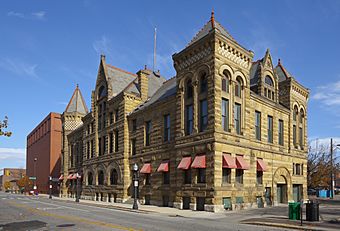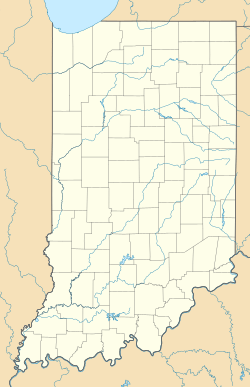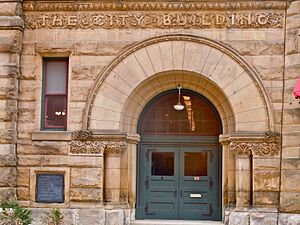Fort Wayne Old City Hall Building facts for kids
Quick facts for kids |
|
|
Fort Wayne City Hall
|
|

Though once functioning as Fort Wayne's City Hall, the building now houses The History Center
|
|
| Location | 302 East Berry Street, Fort Wayne, Indiana |
|---|---|
| Area | 1 acre (0.40 ha) |
| Built | 1893 |
| Architect | Wing & Mahurin |
| Architectural style | Richardsonian Romanesque |
| NRHP reference No. | 73000027 |
| Added to NRHP | June 4, 1973 |
The Fort Wayne Old City Hall Building is a cool historic place in downtown Fort Wayne, Indiana. It used to be the city's main office building. Today, it's a museum called The History Center. Since 1980, it has been the home of the Allen County–Fort Wayne Historical Society.
This amazing building was designed by the architects Wing & Mahurin. It was built in 1893. The style is called Richardsonian Romanesque, which means it has a strong, castle-like look with round arches. The building is made of sandstone. It served as the city's city hall until 1971. That's when city leaders moved to a new building.
In 1973, the building was added to the National Register of Historic Places. This is a special list of places important to American history.
The History Center has collected over 32,000 historical items. Many of these are shown in exhibits that tell the story of the Fort Wayne area. These stories go way back to the Ice Age and continue through the 1700s to today. The Historical Society also owns two other important sites: the Chief Jean Baptiste de Richardville House and the Historic Barr Street Market.
Contents
Explore the Exhibits
The History Center has many interesting exhibits for you to explore. They cover different parts of Fort Wayne's past.
Shaping the Confluence
This exhibit shows how the Fort Wayne area was formed and grew. It includes several cool sections:
- Earliest Inhabitants: Here you can see tools and weapons used by the first people who lived here. There's even a broken rib bone and a large tooth from a mastodon!
- Miami Indian History: This part tells the story of the Miami Indian people. You'll see pictures of important chiefs like Pacanne, Little Turtle, and Jean Baptiste de Richardville. There are also items about Kekionga, which was the Miami capital city. One special item is a sword given to Chief Little Turtle by President George Washington. You can also see a model of what a Miami village looked like in the 1700s.
- Anthony Wayne: Learn about how Fort Wayne got its start. This exhibit explains how General "Mad" Anthony Wayne ordered a fort to be built where three rivers meet. This happened on October 22, 1794.
- An Emerging City: Discover how Fort Wayne grew into a busy city. This section includes a model and parts of the Wabash and Erie Canal. This canal helped the city become a "boom-town" in the 1800s, meaning it grew very quickly.
Industry and Transportation
This exhibit shows how Fort Wayne became a center for making things and moving them around. You can see a recreated blacksmith shop and a foundry. It also talks about Fort Wayne's long connection with railroads.
Innovation and Technology
This new gallery opened in 2012. It highlights many cool products that were invented and made by clever people in Fort Wayne and Allen County.
Old City Jail
This part of the Old City Hall building used to be the Police Department. It had offices, a room for questioning people, and a garage for police cars. The most interesting part is the City Jail and the booking area. This small jail was used from 1893 to 1971. It was mostly a temporary place for people to stay while they waited for their court dates.
See Also




